INTRODUCTION
by Phil Bergman
This article will attempt to educate the reader about the present classification and status of many species of palm trees from Madagascar. A lot has changed in the past twenty years. And, undoubtedly, after I write this names will continue to change. thus, what I’m presenting below may no longer be accurate when you read this. But, with descriptions below and photos, I trust that the reader will learn about these amazing palm species from the unique Island of Madagascar.
Below you will find brief notes created in 1998 on various Madagascar Palm species. It includes “names” of palms as we knew them at the time or have come to know them. In 2002 and again in 2010 we have attempted to update this information. The taxonomic data has been derived from Palms of Madagascar by J. Dransfield, et. al. Comments about culture are from our experience or what we’ve learned from others. Notes on cold tolerance are meant as a general guide only and references to “our weather” apply to coastal Southern California weather. In recent years some information has changed and we will try to update this as time goes by.
One must realize that information about the palms in Madagascar has changed over time. For instance, many “species” may become “complexes”. There appear to be multiple forms of such plants like Dypsis decipiens, Dypsis baronii and Dypsis onilahensis. You may have a plant in your garden that looks different than a photograph of that same species published on the Net or in a book. This could be a different form or variety, or perhaps you have a different species altogether. Additionally, new species have been discovered. In summary, realize that the taxonomy is in a state of flux and things are changing year by year. What we know and call things as of today may be different tomorrow.
NOTE: IF YOU CLICK ON THE SPECIES NAMES, IT WILL TAKE YOU TO OUR AVAILABILITY AND SIZES OFFERED. BUT, BE AWARE PRICES AND WHAT WE HAVE CHANGES FREQUENTLY OVER TIME.



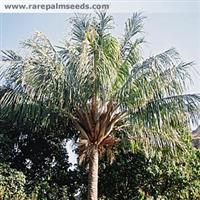
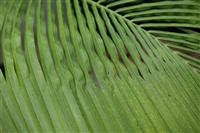
Beccariophoenix madagascariensis and others.
There are presently three forms of this species, one with “windows” in the juvenile foliage, the other without “windows”. The last and most recent species is Beccariophoenix alfredii, the most cold tolerant species. The true “madagascariensis“, is the one with no windows. The windows variety is now called Beccariophoenix fenestralis. All species are single trunk, large palms. The window form is a relatively quick grower where as the windowless form is slower. The windowless species may be easier to grow and more hardy to sun and cold. All species, especially the window form, need lots of iron and microelements or they get very yellow leaves. Cold hardiness about to freezing temperatures. Recent update: A new species, Beccariphoenix alfredii, has been described and is proving to be a great palm for Southern California. Some are even trying to grow it in the SF Bay area.

Bismarckia nobilis
There are green and silver forms of this palm. People tend to like the silver form better. Bismarckias make large, full sun palms. they are easy to germinate and are a good grower, though they do not transplant well; be careful with the roots. It is a deep radicle germinator. It will tolerate lower temperatures when larger, probably in the mid twenties. This palm will certainly be a conversation piece as it is quite beautiful.

Dypsis affinis
This is a small suckering palm that is similar in appearance to Dypsis baronii. It has an attractive white crown shaft and will tolerate full costal sun. Where as the cold tolerance is not yet known, it should be a good palm for Southern California. This palm would be ideal for small areas where filler palms are needed.
Dypsis albafarinosa
This is a very attractive suckering palm which has a lot of color and strikingly white petioles.
Dypsis ambositrae
This is a beautiful, medium sized, solitary palm, though there are reports of suckering types of palm trees. This palm is a fast grower and prefers full sun in most Southern California environments. There is speculation that what nurserymen have domestically grown may not be the “true” Dypsis ambositrae. As a juvenile, the crown shaft and upper trunk have interesting dark colors with white speckling. As a mature specimen this palm has a white crown shaft with thin green recurving leaves and a green trunk. Cold tolerance appears to be in the mid to upper twenties.
Dypsis andrianatonga
This is an understory palm. It is a small colorful palm with clumping, fluffy leaflets and multiple thin trunks. Cold tolerance is not yet known, but probably low thirties. A prominence of speckling on a yellow/green crown shaft. Very cute.
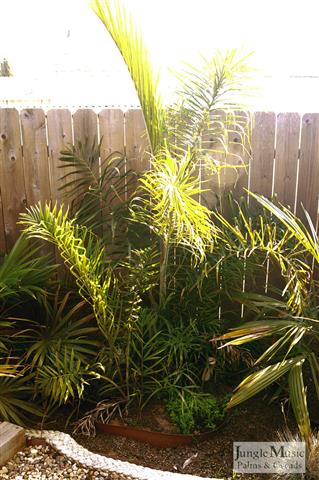
Dypsis ankaizinensis
solitary, medium sized, nice silvery crown with dark speckles. This palm has clustering pendulous leaves with mature foliage and is a slow grower. This palm is a good grower in So Cal
Dypsis arenarium
Had several times; medium sized suckering palm. It’s similar to Dypsis lutescens except that it holds fewer more robust leaves, not sure on cold tolerance.

Dypsis baronii
Suckering, medium sized; red colors when small, later white-silver or green trunk. This is a great for So Cal. It requires AM sun or filtered light. Dypsis baronii appears to get to about 15 or 20 feet. There are color variations in juvenile plants. It is a very desirable tree for Southern California. Seems to tolerate near freezing, perhaps colder.
Dypsis basilonga
This is a rare and graceful palm. It is a small, solitary trunk palm. The crown is adorned with a white waxy color and it has curved leaves; shows promise.

Dypsis bejofo
This is a massive and stunning solitary palm, up to 50 feet trunk. It is slow growing and likes sun; good for So Cal. It has “brain” appearing seeds and root that are stripped like a tiger. In 2002 they are really hard to find in So Cal. nurseries. In warmer habitats like Florida or Queensland, they are knockout beautiful! One of my favorite types of palm trees.
Dypsis boiviniana
This palm is small to medium and can sucker. It has a lot of color, i.e., white, gray and black. It has wide fairly wide, dark green leaflets for its size. Cold status unknown, probably low thirties.
Dypsis brevicaulis
This is a trunk less understory palm. It has a long undivided leaf. Cold status unknown, probably low thirties.
Dypsis brevinodus
Somewhat slow growing; does well outdoors; little data on mature plant.

Dypsis cabadae
Suckering; won’t take a freeze, slow growing; likes AM sun or full sun; has nice green/silver in the trunk and silver, black and green in the crown; perhaps not from Madagascar. D. baronii is probably a better selection.
Dypsis catatiana
This understory palm can have solid or pinnate leaves; it can be either solitary or clustering; it makes a handsome addition to any garden; no cold data yet.
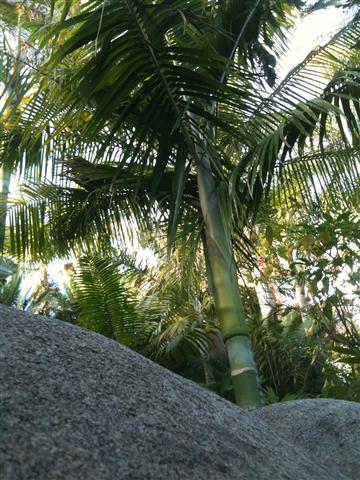
Dypsis ceracea
This is a large solitary palm. It is a slow grower and resembles Dypsis bejofo; it has a pink emergent leaf and makes a beautiful canopy palm. Takes low 30ºs. OK for coastal areas So Cal.
Dypsis “compactus”
Possibly a variety of Dypsis lutescens, this palm has nice color and suckers minimally (3-6 trunks approx.). It has longer leaves and more robust trunks than a Dypsis lutescens. It will take low 30ºs and likes strong filtered light or sun. It is a great palm for So Ca.
Dypsis concinna
True to its name (concinna is Latin for “neat” or “pretty”) this palm is quite attractive. It is a solitary or clustering palm with a nice array or colors. It is a decent growing understory palm. Cold status is unknown, should take mid 30ºs. Would make a nice addition to a garden in a protected spot.
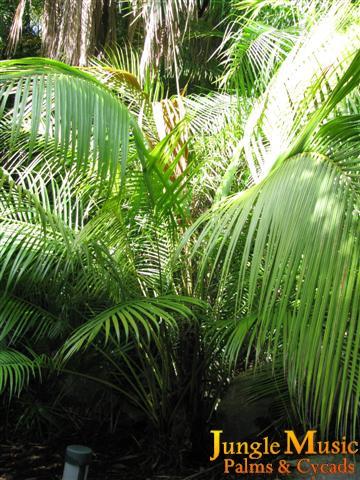
Dypsis crinita
This is a beautiful medium to large palm. It has a fibrous crown, branches and has a new red emergent leaf. It is a fast grower and will take low 30ºs. It is a great palm for So Ca.
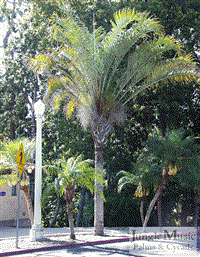
Dypsis decaryi
This palm is commonly known as the “triangle palm”. It is a fast grower and loves the sun (it will die if it is kept in too much shade). It has lots of color and a triangular crown shaft. This palm will take upper 20ºs, but will probably burn. Keep this plant dry when it is cold; this plant likes to be on the dry side in a sandy soil. This plant will not transplant well and is therefore a poor choice for commercial field growing. Great for inland and coastal So Cal.
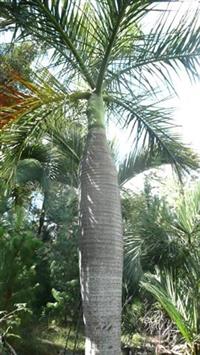
Dypsis decipiens
This is a gorgeous clustering silver palm. It is a slow grower but like a lot of sun and will take a lot of cold, upper 20ºs. This palm can either have a keeled (“V” shaped) leaf or it can have a plumose leaf. This palm is a “must have” for So Cal.
Dypsis eriostachys
This is a slender, solitary understory palm. It bears a thick red/brown tomentum and has an entire leaf. It is an attractive palm, good for shaded/protected areas. Cold status is unknown.
Dypsis faneva
Clustering, small to medium sized; understory; cold status unknown ; very rare and very desirable.
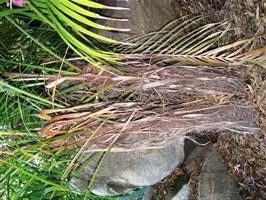
Dypsis fibrosa
This is a small branching or solitary palm. It has a fibrous trunk and a purple/red emergent leaf. It is a moderate grower, but will take filtered light or sun along the coast. Should take mid to low 30ºs. OK for So Cal.
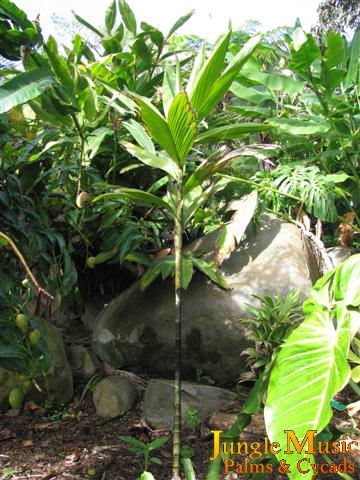
Dypsis florencei
This is a gorgeous multi-colored palm. It can be both solitary or clustering. The trunk is adorned with a “candy stripping” of red, white and black. It seems to tolerate mid 30ºs at least. A must have. A freeze will probably kill this species. Try to get one before you can’t.

Dypsis gracilis
Dypsis gracilis is synonymous with Dypsis pinnatifrons. It is an understory, solitary palm . It has short, grouped, curly leaflets and has a nice green trunk that can bear brownish/black speckling. Cold hardy to low 30ºs.
Dypsis gracilis wide leaf
Similar to above with larger leaflets.
Dypsis heterophylla
This is a small suckering (or sometimes single trunked) palm. Flowers and seeds as a very small plant. This palm has thin green trunks with black speckling. Good for a small filtered light spot in the garden. Cold tolerance probably to low 30ºs.
Dypsis hildebrandtii
This is a beautiful clustering (or solitary) palm. It is an understory palm, rarely reaching above 5-6 feet. It has a solid, or occasionally divided leaflet. The crown and trunk bear reddish/brown fuzz. Overall it is a very nice plant. It like filtered light and should take low 30ºs.
Dypsis hovomantsina
This is a gorgeous mid-sized palm (20-30 feet). It has a waxy silver/white crown with reddish fur at the top. It has long, dark grey/green, plumose leaves. This palm is a slow grower and would like to be in sun along the coast. Cold tolerance not yet known, but it should take the low 30ºs.

Dypsis integra
This palm is quite a beautiful Madagascar palm. It has an entire leaf, which is rounded at the ends. It has nice color (red, white and green) and is a moderate grower (can reach up to 6 feet). Cold tolerance is not yet known, but it is quite rare and sought after (is worth a try).
Dypsis jumelleana
This is a medium sized clustering palm. It has thin green trunk and prefers filtered or morning sun. Slow to moderate grower. Cold tolerance not known.
Dypsis sp. “kingali”
This palm is a knock-out. It is a fast growing, medium sized palm. 2002 update, all people have been very pleased with the speed of growth and beauty of this palm (people love it). It will take the high 20ºs (28-29) without problems.

Dypsis lanceolata
This is a very beautiful palm. It is one of the nicest clustering palms available. It has very nice color and broad leaflets. It is a moderate grower and prefers partial sun or morning sun along the coast. Should be a good grower for Southern California.
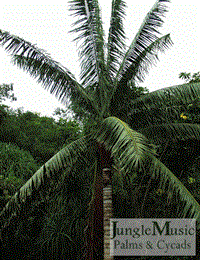
Dypsis lastelliana
This palm is very nice. It has long drooping leaflets and the petioles weep toward the trunk. It has a thick red/brown fur. It is quite similar to the “teddy bear” palm (Dypsis leptocheilos, see below), but it is slower and is more difficult to grow. Will take the low 30°s.
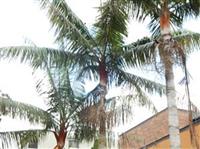
Dypsis leptocheilos
This is one of the most beautiful palms of Madagascar. It is a medium sized palm that takes full sun along the coast. It has a reddish/brown fuzzy crown (which is why it has the nick-name “teddy bear palm”) and a very nice silver/green trunk with white rings. In my opinion this is a must in a palm garden. Will take low 30°s.
Dypsis leptocheilos x decaryi
This is a nice palm. It is a medium sized palm which prefers full sun. It looks like a fuzzy (reddish/brown) Dypsis decaryi (triangle palm). This palm should be a good grower for Southern California. Cold tolerance unknown at this time (probably 30°s).
Dypsis leptocheilos, triangular. crown shaft
This is an unknown species at this point. The trunk shape is triangular like the Dypsis decaryi with reddish/brown fuzz; the leaves and trunk bear a lot of similarities to Dypsis leptocheilos. This palm more resembles a “teddy bear” than the Dypsis leptocheilos x decaryi hybrid. This palm is worth a try. Cold tolerance is unknown (probably 30°s).

Dypsis lucubensis
This is a nice medium sized palm with single or multiple trunks. See Dypsis. madagascariensis below for more information.
Dypsis lutea
This is a very rare dwarf palm. It can be both solitary or clustering. It has light green, large undivided leaves and a thin trunk(s). Very nice and very desirable. It worth a try if you can find it. Cold tolerance is not known.
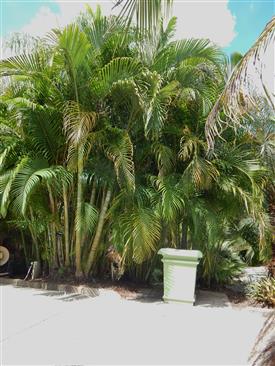
Dypsis lutescens
This is one of the more common Madagascar species. It is a multiple trunked, medium sized palm. It has a lot of color, i.e., white, yellow and some black/brown speckling to the trunk. Dypsis lutescens is a moderate grower and will do well in Southern California. This palm would like to be in full sun or partial sun. Cold tolerance is in the low 30°s to upper 20°s.

Dypsis madagascariensis
This is a medium sized solitary or clustering palm. It has a plumose leaf and nice color (blue-green, white and some black) to the crown. It is a moderate to fast grower and likes to be in full sun. A great palm for gardens in Southern California. Cold tolerance is in the 30°s. (Synonymous with Dypsis lucubensis.)
Dypsis “mahajanga”
This is a medium sized suckering palm. It is a moderate to fast grower and likes partial to full sun. It has nice color and its trunks are of medium caliper. Should be a good palm for most areas in Southern California.

Dypsis mananjarensis
This is a phenomenal solitary palm. It is a large tristichous palm with plumose leaves. It has a thick dark green leaves with black striations (known as “mealy bug”) on the petiole. This palm likes to be in partial to full sun. This is a great palm for Southern California; it is a slow grower, but is well worth the wait. Cold tolerance should be in the mid to low 30°s.
Dypsis mcdonaldiana
This is a very nice solitary or clustering understory palm. It has dark green leaves and black/reddish-brown tomentum on the trunk(s). It is a moderate grower. Would be a nice addition to any shady spot in your garden. Should take low 30°s.
Dypsis monimoni
Unusual species, probably something else; described as a real collector item; should be a good plant for Southern California
Dypsis moorei
This is a massive, litter trapping understory palm. This is an untidy palm as it holds on to old leaf bases and tends to be a magnet for falling debris. Slow grower. Should take low to mid 30°s.
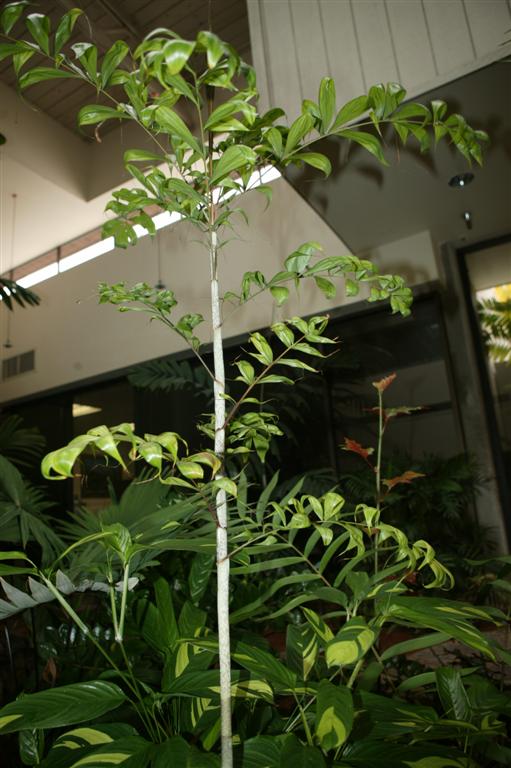
Dypsis nodifera
This is a great solitary palm. It bears a lot of color in the crown and trunk: black, brown, green and white. The leaflets and fat and cluster in groups along the petiole. This plant likes shade or morning sun (along the coast). It has a thin trunk and looks very nice when it is planted in groups of 2 or more. A great grower (very fast) for Southern California. Cold tolerance is low 30°s to upper 20°s.

Dypsis onilahensis
This is a medium, clustering (sometimes solitary) palm. This is one of the more cold hearty and beautiful suckering palms from Madagascar, though it is a slow grower to begin with. It has keeled dark green leaves and a waxy white crown. It prefers to be grown in full sun. A must have for the garden. Cold tolerance upper to mid 20°s.

Dypsis pembana
This is a tall, solitary (rare) palm from Tanzania and Pemba Island. This is a knock-out palm. It has medium sized, slightly arching dark green leaves. It thin green trunk with white growth rings. It is a moderate to fast grower. It is a great palm for Southern California. Cold tolerance is 30°s.
Dypsis perrieri
This is a medium sized, solitary palm with a massive trunk. It is a pretty palm, though litter trapping, with reddish (tomentose) flowers. It is a slow grower, but is definitely worth a try here in Southern California. Cold tolerance is not known, but it should take mid 30°s.
Dypsis pinnatifrons
This is a nice medium sized, solitary palm. It is quite similar to Dypsis nodifera. It does not like too much heat, and looks it best when grown in a shady environment (possibly some morning sun). It is a moderate to fast grower and is a good choice along the cost. Cold tolerance is low to mid 30°s.
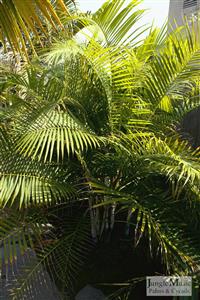
Dypsis psammophila
Small suckering palm. It is similar to Dypsis lutescens, though it has smaller, thinner trunks. It partial to full sun (along the coast). It is worth a try. Cold tolerance not know, probably mid to low 30°s.
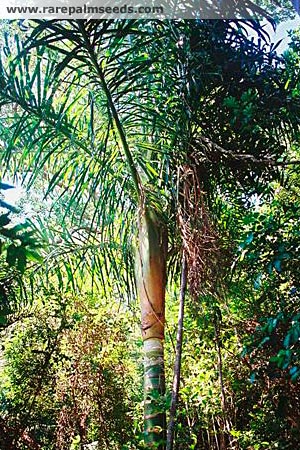
Dypsis prestoniana
This is a great, solitary palm. It is medium to large sized with a medium sized, green trunk (10 inches or so). It has long plumose, arching leaves. It is a very beautiful and elegant palm. It likes to be grown in partial sun or full sun along the coast. It is definitely needed in a sophisticated garden. Cold tolerance in the 30°s.

Dypsis procera
This is a nice clustering palm. It is small to medium sized with entire leaflets. It has a lot of greens, blacks and browns. Makes a great filler plant for those little shady areas in your garden. It’s definitely worth a try in Southern California. Cold tolerance in the low 30°s.
Dypsis pussila (vonitra)
This is a very cute dwarf palm. It is the smallest of the vonitra (now Dypsis) family. It is fairly fast considering its mature height and has a very nice reddish-purple emergent leaf. It has a fibrous crown and can be either solitary or branching. This palm is definitely worth a try. Cold hardy from mid to low 30°s.

Dypsis rivularis
This is a medium sized, solitary palm. It is a crown shafted palm with stilt roots and clustered leaflets. It is a nice palm but tends to be messy and litter trapping. It is a moderate grower and should do fine in warmer/coastal parts of Southern California.
Dypsis rivularis pink crown shaft
Same description as above, but this one has a pink colored crownshaft.

Dypsis saintelucei
This palm is a true gem. It is a medium sized, solitary palm. It has long, arching, elegant petioles that are blackish/brown in color. Its leaves are keeled and are dark green with a slight blue tinge on the under side. The crown is a silver/white with a black/green trunk that has white growth rings. It is a must have in the garden. It likes full sun and is a moderate to (fairly) fast grower. Cold tolerance not yet known.

Dypsis sanbiranensis
This is a very nice solitary palm. It has a rusty brown color petiole with some dark speckling and long, thick, green leaflets. It is a moderate grower and prefers partial sun or possibly more along the coast when young, it can grow into full sun. It makes a medium to large palm. Cold hardy to low 30°s to upper 20°s.

Dypsis sanctaemariae
This is a small, clustering understory palm from Isle Sainte Marie (near Madagascar). It has entire leaves and tends to be litter trapping. It has a brownish crown and some red to the petioles. It is a nice palm, and is worth trying in Southern California. Cold tolerance mid-low 30º.
Dypsis scottiana
This is a colorful, understory palm. This palm has lots of color: black, whit, green and some grey. It is a slow grower, but is worth the wait. It has Chamaedorea like features and prefers a shady environment. Should be a good palm for coastal California. Cold tolerance mid-low 30º.
Dypsis simianensis Undescribed species; no cold or growing data yet
Dypsis sohanofensis
This is a magnificent medium sized suckering palm. The palm has great color and the leaflets are clustered along the petiole. It should be a great plant for Southern California. Growth is slow to medium and cold tolerance is mid-low 30º.
Dypsis sp. “96pn2” Un-named species; tolerates full sun; cold hardy.
Dypsis sp. “96pn3“ Same as above; unknown species.

Dypsis sp. “bef” Australian name.
Dypsis sp. “Bresy”
Medium growth rate; OK for So Cal; controversy over adult appearance. May be similar to Dypsis hovomantsina.
Dypsis sp. “laffa”
One of the original “unusual” Dysis. This palm has a white petiole and is subterranean for a long time. It has fat, glossy, green leaflets; new emergent leaves are a pink or red color. Dypsis sp. laffa is similar to Dypsis ceracea. Should be ok for Southern California

Dypsis sp. “diego“
Like a D. madagascariensis with nice colors, fast growing, cold hardy most areas; nice colors.
Dypsis sp. “dwarf” little data, understory.
Dypsis sp. “last. mealy bug” Unknown species; “mealy”; single trunk; unknown cold tolerance; somewhat slow.
Dypsis sp. “rare, cult. Hawaii”
Also known as Dypsis sp. “carlsmithii.” This is a large palm with nice color; it has a green trunk with white rings and a brilliant orange color crown. Although this palm does become large it is a slow grower. It prefers full sun and should take into the low 30º.
Dypsis sp. “St. Mariensis“

Dypsis sp. “stumpy” (HI)
See “Dypsis rare cult. Hawaii” above.

Dypsis sp. “triangular lastelliana”
This palm is quite beautiful. This hybrid takes on some of the best characteristics of both palms. It is robust and has a triangular crown shaft like the Dypsis decaryi and has long flat leaflets and a red tomentum on the crown like the Dypsis lastelliana. This palm is a moderate grower and wants full sun. It should be a good palm for Southern California. Cold tolerance low 30º.
Dypsis sp. as “blue areca“
Perplexing sp; not sure what is; it does have similarities to Dypsis ceracea. Outside of that there is little data.
Dypsis sp. black stem dark stem; little data.
Dypsis sp.
Broad leaf Madagascar near entire leaf; understory; no data on cold.
Dypsis sp. entire new leaf Ditto.
Dypsis sp. like teddy x decaryi
This palm is very nice. This hybrid has characteristics of both palms; it is robust and has a triangular crown shaft like the Dypsis decaryi and it has red tomentum on the crown like the Dypsis leptocheilos. This palm is slow to medium grower and wants full sun along the coast. It should be a good palm for Southern California. Cold tolerance low 30º.
Dypsis sp. Madagascar X Unknown species, Slow growing, different leaf; cold hardy.
Dypsis sp. mahajunga See description above.
Dypsis sp. newly emerging red leaf
Another unknown species; single trunk; little data.
Dypsis sp. other
Many other unknown types, little data; in time we’ll know.

Dypsis sp. pink crown shaft
Previously know as Noephloga sp. “pink crown shaft”, this palm is a very colorful and desirable understory palm. This palm has a distinctly pink crown and fat clustering leaflets. It is great for shady areas in your yard or possible as a house plant. It should be a good palm for Southern California, cold tolerance probably mid 30This palm is quite beautiful. This hybrid takes on some of the best characteristics of both palms. It is robust and has a triangular crown shaft like the Dypsis decaryi and has long flat leaflets and a red tomentum on the crown like the Dypsis lastelliana. This palm is a moderate grower and wants full sun. It should be a good palm for Southern California. Cold tolerance low 30º.
Dypsis sp. rudaticha No good data on this palm.
Dypsis sp. sim. to forcifolia Unknown species; no data.
Dypsis sp. S.C. Little data, probably cold hardy.
Dypsis sp. mt. type AUnknown species; cold hardy; never seen an adult plant.
Dypsis sp. suckering type B Unknown species; cold hardy.

Dypsis thouarsiana
This will make a large pinnate palm. It is slow growing, likes sun and water. There is not much data on this palm. With probably be like growing Dypsis ceracea. No cold hardy information
Dypsis tokoravina Fantastic large solitary palm , worth acquiring, beautiful large crown; should grow here.
Dypsis trorovana (wide leaf).

Dypsis tsaratananensis
Suckering; high elevation palm; medium sized; grows outdoors.
Dypsis tsaravoasira Tristichous (leaves 3 ranks) medium to tall solitary; beautiful; OK for So Cal.
Dypsis tsiriki (questionable) proved to not be a Dypsis.
Dypsis utilis (vonitra) larger
Solitary or usually few suckers; large trunk; new red leaf; will grow in coastal areas.
Dypsis viridis
Attractive, thin trunked clustering; understory; no cold data
Halmoorea trispatha (Orania trispatha)
Large solitary palm I’ve found difficult to grow outdoors.
Honkona sp. Madagascar unknown species; cold hardy most areas.

Hyphaene coriacea
Branching fan; likes heat and sun; dislikes moisture in winter; good for So Cal.

Lemurophoenix halleuxii
The “red lemur”; red new leaf with black petiole; will get large; great palm; will take low 30ºs; start in filtered light hard to germinate; one of the best Madagascar palms.

Marojejya darianii
Litter trapping, understory, huge near-complete leaf; beautiful; possibly OK for non-freeze areas.

Marojejya insignis
Huge; litter trapping; more petiole than above sp.; pinnate; possibly more cold hardy but not clear.
Marojejya “barinitso”
Previously collected species; little data.
Masoala madagascariensis
Medium to large trunk; solitary; no cold date; rare; worth the try.
Masoala kona
Like Marojejya; large leaves; semi-divided leaves; no cold data; smaller trunk than M. madagascariensis.

Raphia farinifera Huge single trunk; likes sun; survives in So Cal.
Ravenea “nova”New species, no data.
Ravenea albicans
Solitary medium sized; white underneath leaves, red striped petiole; rare; no cold data

Ravenea glauca
Solitary, medium sized, glaucous underside leaves; insufficient cold data. More recently we’ve gotten feedback that this palm takes full sun well, even in inland areas, and is cold hardy to at least the mid-twenties F.
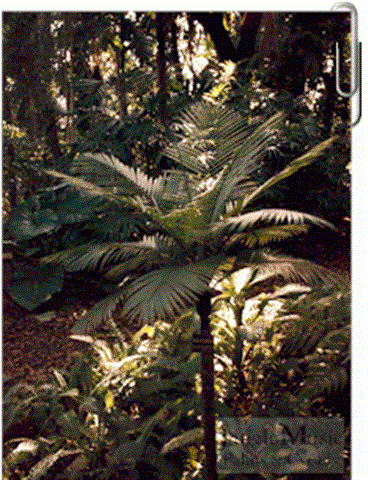
Ravenea hildebrandtii
Small, “miniature” Ravenea; thin trunk to usually 10 – 15 feet only; sun; good for So Cal. More recent feedback is that, even though it’s a short palm, it is a good grower and everyone loves it.
Ravenea juliette
Solitary, medium sized, thin trunk, curved leaves, cold data not available yet, hopeful.
Ravenea krociana
Tall robust solitary palm; sun; should do well in So Cal.
Ravenea lakatra
Medium solitary; stepped trunk; no cold data yet
Ravenea latisecta
Single trunk, medium size; good for So Cal
Ravenea madagascariensis
Medium sized solitary palm, trunk about 6 inches; sun; good for So Cal

Ravenea madagascar. var. monticola
Similar to above, different leaflet; slower than R. rivularis, thinner trunk, long leaves, good for So Cal
Ravenea madagascar. var mt. form
Unknown species, speckled petiole; no data on cold.
Ravenea madagascariensis var. white push
Single trunk, white petiole, glossy green, solitary; good for So Cal.

Ravenea moorei
Comoros single trunk, large, sun loving, extremely rare; Ok for So Cal.
Ravenea musicalis
Likes water (grows near rivers), small to medium single trunk; no cold data.
Ravenea nana
Another miniature Ravenea; slow growing when young; solitary; no cold data.

Ravenea rivularis
Large palm, “majesty”; big trunk; needs microelements or yellows; fast; good for So Cal. However, poor choice for locations immediately along the beach. Can develop a type of crown problem with distorted, malformed leaves.

Ravenea robustior
Huge solitary palm; doesn’t like Santa Ana winds; possibly good for outdoors.

Ravenea sanbirianensis
Beautiful medium sized solitary palm with curved leaves; full sun; good for So Cal.
Ravenea sp. Unknown species; no cold data.
Ravenea sp. “Anivekely”
Undescribed species; no cold data yet but promising.
Ravenea sp. “honkona“
Unknown sp; grouped leaflets, slow; cold hardy So Cal.
Ravenea sp. marinjo
Undescribed species; no cold data.
Ravenea sp. savorona
Undescribed species; no cold data
Ravenea xerophyla
Arid species, single trunk, blue-green, slow growing, peculiar germination; likes hot and dry
Satranala decussilvae
“Forest Bismarckia”; fan palm; difficult to germinate, remote germinator; slow; should grow here, likes moisture.
Voanioala gerardii
“Forest Coconut” large palm; extremely difficult to germinate; may grow here.
Almost all of the above species are presently being grown at the nursery
(End)
- PALM TREES, CYCADS & TROPICAL PLANT BLOG - October 1, 2020
- TRACHYCARPUS
The Windmill Palm - September 30, 2020 - FAN PALMS –
PALMS WITH CIRCULAR LEAVES - September 29, 2020












